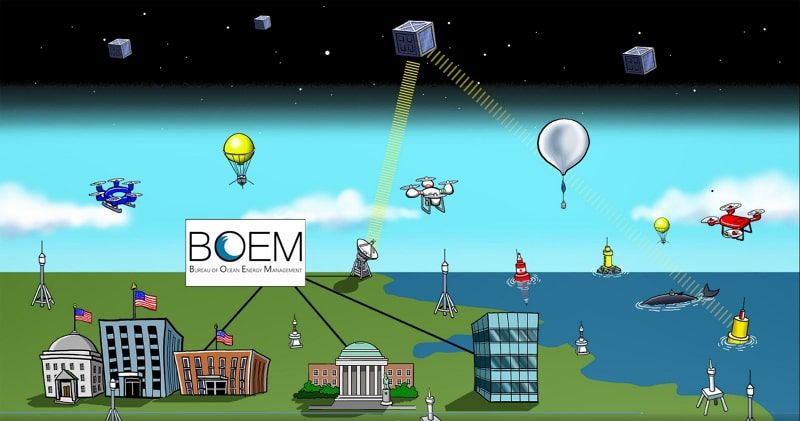Aztech-Sat: the development of small satellites to track marine animals
This project, known as "Aztech-Sat," has the goal of developing a monitoring system that makes use of artificial satellites by combining open-source software with commercially available hardware. Find out more information on this endeavor.

At the invitation of the National Aeronautics and Space Administration (NASA) of the United States, and with the support of the Mexican Space Agency (AEM), UNAM -and four other Mexican universities- is participating in the design and construction of four identical 10x10x10 centimeter mini-satellites (called CubeSat, due to their cube design), which will orbit the Earth to track marine animals that migrate from the north and south poles to the equator and back.
The "Aztech-Sat" project is a constellation of satellites that will travel to the planet's exterior in a consecutive and orderly manner, which will be put into orbit in a mission planned by NASA for 2025. The announcement was made during the Third National Congress of Space Activities (CONACES 2022), organized by the AEM, in Aguascalientes.
The director of the Institute of Astronomy of the National University, Jesus Gonzalez Gonzalez, referred that space is strategic and relevant to the Earth and in the large planetary, galactic and cosmological scales. "The human being, from all educational, professional and national levels, must explore and exploit it, in the best of senses".
Andrés Martínez, the technical representative of the U.S. space agency for Latin America, stressed the importance of collaboration and training of human capital in space. "We are facing a great scientific and technical challenge because we have to work with Mexican teams from different universities as a single team".
This joint exercise will be relevant because this is how NASA works with specialists from all over the world.
In his turn, the general director of the AEM, Salvador Landeros Ayala, stated that with plans such as AztechSat, knowledge, and experience are assimilated, to scale in the construction of larger satellites and more ambitious projects that promote research and the training of human resources in the area.
University potential of the Aztech-Sat
The National University will develop one with the support of the High Technology Unit (UAT), the Faculty of Engineering (FI), the national laboratories of Space and Automotive Engineering (LN-INGEA, attached to the FI), and Earth Observation (LANOT, attached to the Institute of Geography), as well as specialists from the Institutes of Astronomy (IA) and Geophysics (IGf), detailed in a subsequent interview the coordinator of the University Space Program (PEU), José Francisco Valdés Galicia.
"The Institute of Astronomy is part of the PEU and participates with some of our engineers. Our specific role is to support, from the technical and scientific point of view, what the project requires," Jesús González González also assured in an interview.
The cost of the university CubeSat will be 10 million pesos, lower than the budgets previously spent on satellites, which were tens or hundreds of millions of pesos. The other three will be in charge of the Popular Autonomous Universities of Puebla and Panamericana -they will develop one each- while the Aeronautical University of Queretaro and the Polytechnic University of Queretaro will build a team between them.
The idea is to implement a marine species monitoring system with significant improvements, such as greater geographic coverage, lower investment costs, and greater bandwidth for data transmission added Valdés Galicia.
"The equipment that has been used for 10 to 15 years in the United States to carry out this monitoring needs to be updated because today they have limitations in the sensors that are placed on large marine animals so that they can transmit tracking data to the satellites. This will be the first project of its kind in the world in which Mexico participates with more modern technology," he said.
Large marine species such as whales, sharks, and sea lions will carry the sensors on their bodies and the signals they emit will be captured by the CubeSats (weighing from one to 1.33 kilograms) to follow their trajectories and migrations, learn about their habits and how climate change affects them.
The project will create a marine species monitoring system based on artificial satellites implemented with free software and commercially available hardware.
"Scientifically, the aim is to generate a database of movement and location of marine species for large-scale research. From the technological point of view, from the development of the satellite, it seeks to create technology with software or commercial electronic programs so that it can lower costs," explained Gonzalez Gonzalez.
The entities promoting the plan are NASA; the Bureau of Ocean Energy Management (BOEM), which is in charge of monitoring the responsible exploitation of the energy, mineral, and marine resources of the United States outer continental shelf, by environmental protection and preservation guidelines; and the AEM, the public agency in charge of coordinating Mexico's space policy.
Today the project is formalized and we are starting with the designs and the components that the equipment must have. The important thing is that we have guaranteed the launch because it is a project at NASA's invitation and that we have their knowledge and support so that our undergraduate and graduate students can take advantage of it, Valdés Galicia added.
The IA director clarified that the four mini-satellites will be identical and will develop a kind of kit that can be acquired, assembled, and learned about them by different entities in the country, initially the five participating universities. "The equipment, in addition to its scientific work with the tracking of marine animals, will serve to train students and engineers in the use and development of these technologies," he said.




